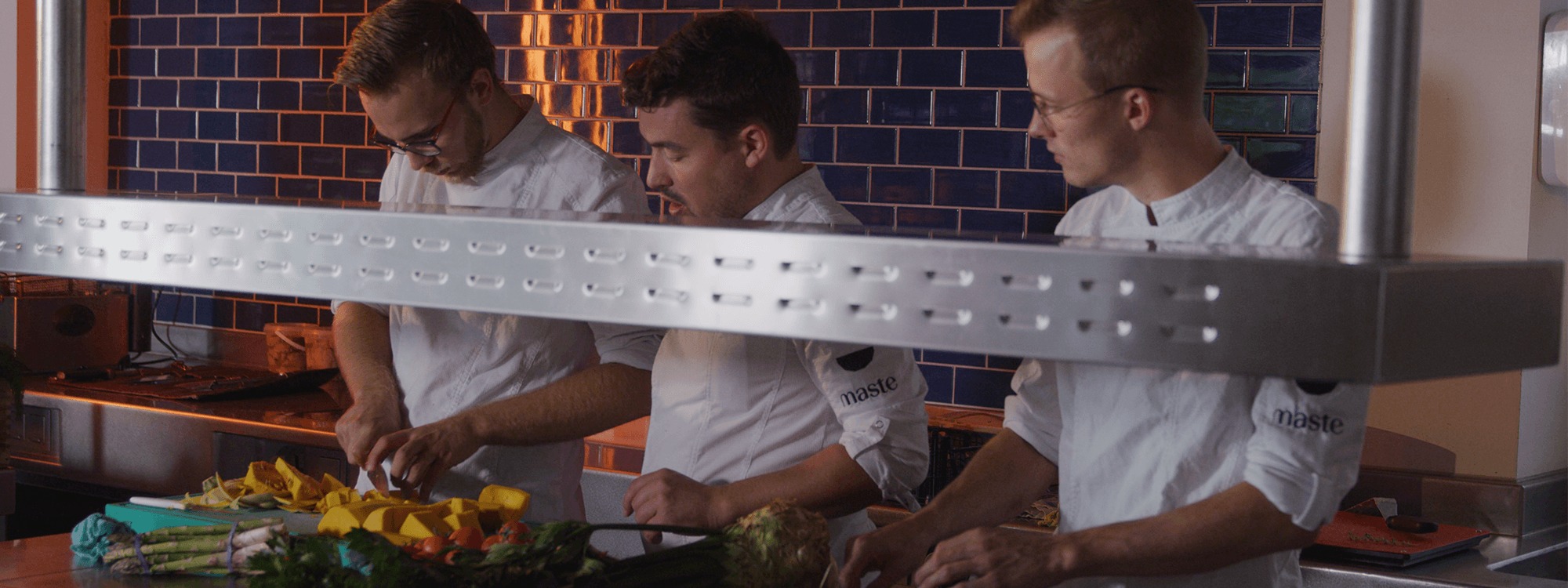
In the hospitality industry, impeccable food safety and kitchen hygiene practices are crucial. With over 200 diseases spread through food, ensuring your venue goes above and beyond when it comes to hygiene is the best way to keep staff and customers safe and your reputation intact.
Kitchen hygiene checklist
To help make sure you’ve covered all bases we’ve created a kitchen hygiene checklist for your restaurant.
- Staff hygiene and presentation
- Food safety practices
- Protect against pests
- Sanitise
- Create a cleaning schedule
- Kitchen safety
- Organise your stock and storage areas
- Check government and state guidelines
How To Keep COGS Low & Margins High
The ultimate restaurant back of house (BOH) eGuide to increase profit margins. A joint resource from Lightspeed & FoodByUs, this guide shares industry insights on optimising your BOH process so you can ultimately keep your COGS low and margins high.
Staff hygiene and presentation
Prioritising staff hygiene is crucial in preventing food contamination and it’s always good to document exactly what is expected from your staff when it comes to their personal presentation and hygiene.
For example, your front of house and back of house staff will have different requirements due to the nature of their roles. Providing staff with regular training and having an easily accessible staff hygiene checklist is a great way to ensure everyone knows what is expected of them.
Clothing
- Aprons should be worn when working with food and when washing dishes
- Disposable gloves should be worn when handling easily perishable or high risk foods
- A hat and/or hair net should be worn if working in the kitchen
- Shoes should be fully covered and non-slip
- Work clothes should be regularly washed and free from stains
- Accessories such as watches and rings should be removed
Personal hygiene
- Nails should be clean and cut short
- Hair should be neat and tied back
- Injuries (cuts, sores, burns, etc.) must be properly dressed and covered with waterproof bandages
- Hands should be washed regularly
- Do not sneeze or cough near food
Food safety practices
Impeccable food safety practices should be a top priority for any business that prepares and sells food. A few careless mistakes or not enough attention to detail can have serious consequences for a restaurant. Therefore it’s crucial for all staff to be aware of, and trained in, food safety practices and regulations.
Here are some of the basic food safety practices every restaurant should follow:
- Label food – food should be labelled correctly, with a clear indication of its use by date.
- Cross contamination – cooked and raw foods should never be stored in close proximity. It’s also important to use separate utensils and chopping boards when preparing raw and cooked food to avoid cross contamination.
- Chill food – don’t leave perishable items out at room temperature for too long. These items should be stored in a fridge to prevent harmful bacteria from forming.
- Cook at the right temperature – make sure you cook items, particularly meat, at the right temperature.
- Wear disposable gloves – if you’re preparing things like sandwiches or salads it’s a good idea to wear disposable gloves to protect the food from contamination. It’s also important to regularly change your gloves.
- Replace disposable tools – make sure to regularly throw away things like dish cloth and cleaning sponges as they can harbour germs and spread around your kitchen.
- Wash hands – hands should be washed regularly, especially after handling raw meat or fish, going to the bathroom, smoking, touching dirty dishes and taking out the trash.
Tip: Designate a member of staff as a food safety supervisor to ensure that guidelines are being followed and food safety standards remain high.
For a comprehensive breakdown of food safety standards in Australia and New Zealand, please click here.
Restaurant Employee Handbook Template
Standardize your restaurant's policies, guidelines and processes with your custom restaurant employee handbook.
Protect against pests
Taking steps to protect your kitchen (and wider venue) against pests such as cockroaches, rats and flies will reduce the risk of contamination. Make sure bins are regularly emptied and cleaned, store food off the ground in sealed containers, regularly clean floors and surfaces, dispose of food waste, maintain doors and windows and use professional pest control services to regularly check your venue.
Sanitise
To maintain a high standard of kitchen hygiene it’s important to sanitise your surfaces, equipment, utensils, bins (pretty much everything) on a regular basis. Make sure your kitchen is fully equipped with the best sanitising agents and cleaning equipment such as cloths, mops, buckets and brooms. This equipment should then be stored in a separate and secure area.
Items, equipment and areas that need regular sanitisation:
- Fridges and freezers
- Waste bins
- All surfaces
- Floors, walls and ceilings
- Utensils
- Chopping boards
- Dishwashers
- Ovens, grills, fryers, etc.
Sticking to a consistent sanitising schedule will ensure your equipment is maintained and functioning properly. Clean equipment is more likely to run efficiently, saving you precious dollars on maintenance and energy bills.
Create a cleaning and safety schedule
Create a schedule that’s clearly displayed in your kitchen or back office and assign certain members of staff to oversee it. The cleaning and safety schedule should include tasks that need to be done daily, weekly, monthly and annually and should be signed off once completed.
It should include daily tasks such as emptying bins, mopping floors, cleaning toilets and sanitising surfaces. It’s also important to schedule less regular tasks such as a monthly deep clean of the freezer, washing walls and ceilings and refiling the first aid kit. Having a clear schedule for when items should be cleaned and to check for hazards means nothing is left to chance and you’ll always have a record of what has been done and when.
Kitchen safety
Kitchens can be dangerous places at the best of times and during peak hours accidents are more likely to happen. Making sure your kitchen is a clean and safe environment to work in not only protects your staff, it will also improve your kitchen hygiene. To reduce the risk of serious accidents, make sure to:
- Store dangerous objects safely
- Clean up any spillages, especially on the floor, immediately
- Turn the gas off when the cooker isn’t in use
- Have a fire extinguisher that meets safety standards and regularly test fire alarms
- Make sure emergency exits aren’t obstructed
- Always have a fully stocked first aid box within easy reach
Organise your stock and storage areas
Keeping your stock and storage areas organised makes it easier to clean and you can also keep an eye on expiry dates. Make sure all containers are kept off the floor and regularly check if they have any cracks, are broken or have damaged labels.
Check government and state guidelines
Regulations that govern things like kitchen hygiene, food safety and kitchen safety can differ from state to state so it’s important to check your local laws and guidelines. For more information on regulations in your state, please click one of the links below.
- Australian Capital Territory
- New South Wales
- Northern Territory
- Queensland
- South Australia
- Tasmania
- Victoria
- Western Australia
The importance of kitchen hygiene
At the risk of sounding like a dreary school teacher, we can’t stress enough how important it is to implement kitchen hygiene practices. While it can sometimes be tempting to cut corners and save money, maintaining a high standard of hygiene is the best way to prepare your business for success.

News you care about. Tips you can use.
Everything your business needs to grow, delivered straight to your inbox.


